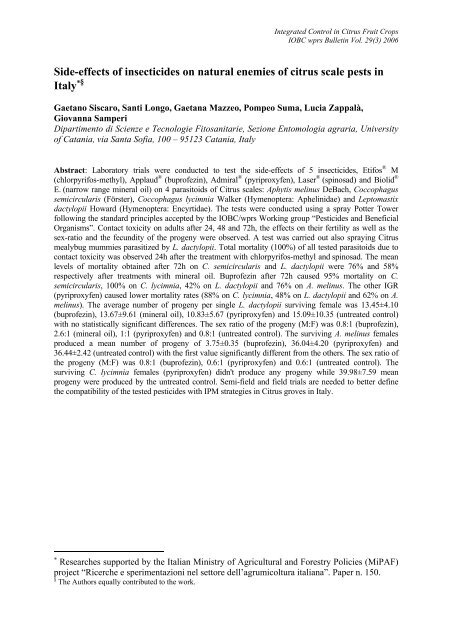Integrated Control in Citrus Fruit Crops - IOBC-WPRS
Integrated Control in Citrus Fruit Crops - IOBC-WPRS
Integrated Control in Citrus Fruit Crops - IOBC-WPRS
You also want an ePaper? Increase the reach of your titles
YUMPU automatically turns print PDFs into web optimized ePapers that Google loves.
<strong>Integrated</strong> <strong>Control</strong> <strong>in</strong> <strong>Citrus</strong> <strong>Fruit</strong> <strong>Crops</strong><br />
<strong>IOBC</strong> wprs Bullet<strong>in</strong> Vol. 29(3) 2006<br />
Side-effects of <strong>in</strong>secticides on natural enemies of citrus scale pests <strong>in</strong><br />
Italy ∗§<br />
Gaetano Siscaro, Santi Longo, Gaetana Mazzeo, Pompeo Suma, Lucia Zappalà,<br />
Giovanna Samperi<br />
Dipartimento di Scienze e Tecnologie Fitosanitarie, Sezione Entomologia agraria, University<br />
of Catania, via Santa Sofia, 100 – 95123 Catania, Italy<br />
Abstract: Laboratory trials were conducted to test the side-effects of 5 <strong>in</strong>secticides, Etifos ® M<br />
(chlorpyrifos-methyl), Applaud ® (buprofez<strong>in</strong>), Admiral ® (pyriproxyfen), Laser ® (sp<strong>in</strong>osad) and Biolid ®<br />
E. (narrow range m<strong>in</strong>eral oil) on 4 parasitoids of <strong>Citrus</strong> scales: Aphytis mel<strong>in</strong>us DeBach, Coccophagus<br />
semicircularis (Förster), Coccophagus lycimnia Walker (Hymenoptera: Aphel<strong>in</strong>idae) and Leptomastix<br />
dactylopii Howard (Hymenoptera: Encyrtidae). The tests were conducted us<strong>in</strong>g a spray Potter Tower<br />
follow<strong>in</strong>g the standard pr<strong>in</strong>ciples accepted by the <strong>IOBC</strong>/wprs Work<strong>in</strong>g group “Pesticides and Beneficial<br />
Organisms”. Contact toxicity on adults after 24, 48 and 72h, the effects on their fertility as well as the<br />
sex-ratio and the fecundity of the progeny were observed. A test was carried out also spray<strong>in</strong>g <strong>Citrus</strong><br />
mealybug mummies parasitized by L. dactylopii. Total mortality (100%) of all tested parasitoids due to<br />
contact toxicity was observed 24h after the treatment with chlorpyrifos-methyl and sp<strong>in</strong>osad. The mean<br />
levels of mortality obta<strong>in</strong>ed after 72h on C. semicircularis and L. dactylopii were 76% and 58%<br />
respectively after treatments with m<strong>in</strong>eral oil. Buprofez<strong>in</strong> after 72h caused 95% mortality on C.<br />
semicircularis, 100% on C. lycimnia, 42% on L. dactylopii and 76% on A. mel<strong>in</strong>us. The other IGR<br />
(pyriproxyfen) caused lower mortality rates (88% on C. lycimnia, 48% on L. dactylopii and 62% on A.<br />
mel<strong>in</strong>us). The average number of progeny per s<strong>in</strong>gle L. dactylopii surviv<strong>in</strong>g female was 13.45±4.10<br />
(buprofez<strong>in</strong>), 13.67±9.61 (m<strong>in</strong>eral oil), 10.83±5.67 (pyriproxyfen) and 15.09±10.35 (untreated control)<br />
with no statistically significant differences. The sex ratio of the progeny (M:F) was 0.8:1 (buprofez<strong>in</strong>),<br />
2.6:1 (m<strong>in</strong>eral oil), 1:1 (pyriproxyfen) and 0.8:1 (untreated control). The surviv<strong>in</strong>g A. mel<strong>in</strong>us females<br />
produced a mean number of progeny of 3.75±0.35 (buprofez<strong>in</strong>), 36.04±4.20 (pyriproxyfen) and<br />
36.44±2.42 (untreated control) with the first value significantly different from the others. The sex ratio of<br />
the progeny (M:F) was 0.8:1 (buprofez<strong>in</strong>), 0.6:1 (pyriproxyfen) and 0.6:1 (untreated control). The<br />
surviv<strong>in</strong>g C. lycimnia females (pyriproxyfen) didn't produce any progeny while 39.98±7.59 mean<br />
progeny were produced by the untreated control. Semi-field and field trials are needed to better def<strong>in</strong>e<br />
the compatibility of the tested pesticides with IPM strategies <strong>in</strong> <strong>Citrus</strong> groves <strong>in</strong> Italy.<br />
∗ Researches supported by the Italian M<strong>in</strong>istry of Agricultural and Forestry Policies (MiPAF)<br />
project “Ricerche e sperimentazioni nel settore dell’agrumicoltura italiana”. Paper n. 150.<br />
§ The Authors equally contributed to the work.

















